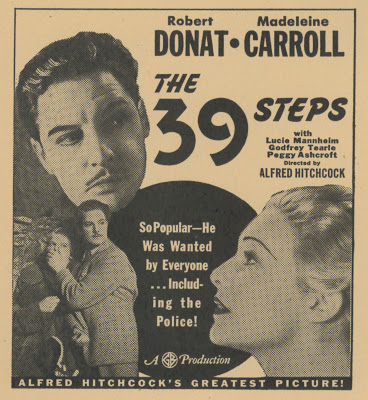Just Found Photos --- A New Feature
The GPS Scrapbook is where I'll post still curios from time to time. These tend to be oddities I like, but wouldn't necessarily fit into topics addressed at Greenbriar. The idea, as always, is to lay down stuff that's unfamiliar ... all these were unseen, at least by me, until recently ... and the search goes on for more along similar lines.
Like all of us, George Arliss was young once. It's just difficult to picture him that way. Actually, until this image surfaced in a Brit fan periodical, I'd never seen Arliss in pre-monocle mode. That's him on the left, recognizable in a way, though I wouldn't necessarily expect this young man to mature into the singular visage that would eventually be Arliss'. Was there ever a face like his? --- and yet, this youth looks comparatively normal, eyes set close, a serious mien, ready even then to assume his place on a world's stage. I'll need to revisit Bob Fells' excellent George Arliss: The Man Who Played God to read further on boy years re GA. It goes without saying that any of this actor's films are worth another look-in. Remember when Arliss was just a picture in books? --- his pics had fled tubes and it wasn't until TCM that we could see them again ... that being the case at least where I was. There's more Arliss at Greenbriar here.
The caption says Biggest Contract Of His Career, and gathered is as potent an aggregation of MGM power as one could locate in February, 1951. I think they're in Mayer's office, judging by a framed portrait of L.B. pal Herbert Hoover. No doubt it was inscribed in terms of forever friendship. Could Mayer have imagined he'd be off the lot within months of here? On the left stands Eddie Mannix. I wish someone would write a book about him, as Eddie day-to-day managed the place and was well regarded by talent (Clark Gable said a Mannix handshake was good as any contract). Dore Schary, Mayer's successor, has been much maligned, unfairly I think. Signatory Pete Smith's the one I gag on. His voice always activates my mute button. Exhib polls are said to have placed Smith shorts at Number One for seven years. His ten minutes in a show would be ones I'd have spent shopping concessions. At right stands Fred Quimby, of cartoon recognition if not much creative participation. Fred was chief of the shorts department, thus his credit on single reels shipping out of Culver.
Good fellowship abides here --- does this group photo reflects truth of studio life during the early thirties? We'd like to think so. There's an interview where Buddy Rogers talked about voice testing he and contract pals took to determine their
Speaking of positive identification, this saucy image was caption tendered as Merna Kennedy's, lead lady to Charlie Chaplin in The Circus. I've not seen her in portraiture approaching hotcha level of this, and wonder when and to what purpose the sitting took place. She had a career of sorts post-CC. Mostly smallish, some B westerns. You'd think Merna was jinxed for appearing with Chaplin. Didn't pretty much a same thing happen with Georgia Hale? She finished in westerns too, plus Rin-Tin-Tin's serial bow-wow-out, The Lightning Warrior. Merna Kennedy remains a mystery for dying young, age 36 in 1944, amidst obscurity. She'd been married once to Busby Berkeley, which couldn't have been easy. Times must have been tough toward the end (
Offscreen George Nader was anything but "The Women's Date For '58," but was, as evidenced here, good enough sport for going along to get along (and collect UI paychecks). I can't begin peeling off all the layers of artifice here. There weren't many years left for
Eddie Mannix again. This time with the wife. I'd like a book on Toni too. Wait ... there's already several ... only it's George Reeves on the covers. Mrs. Mannix (still very much a Mrs.) was Superman's off-set cohort, even when this pic was snapped in 1951. Toni had a few years on George and, by most accounts, played sort of mother in addition to mistress for him. He should have stayed with her, I think. She seems to have been a stabilizing influence, and Mama often kicked in when her Man Of Steel ran cash short. Toni had been a showgirl, so knew lean times, and possessed more worldly ways than Reeves. As to the husband, I doubt he cared by this juncture. To say Eddie killed George (or had it done) is nonsense. Toni got to spend old age harassed by Superman nuts wanting revelation she couldn't give, Eddie lucking out with a '63 exit well short of fans maturing (?) to inquisitive age.




















































